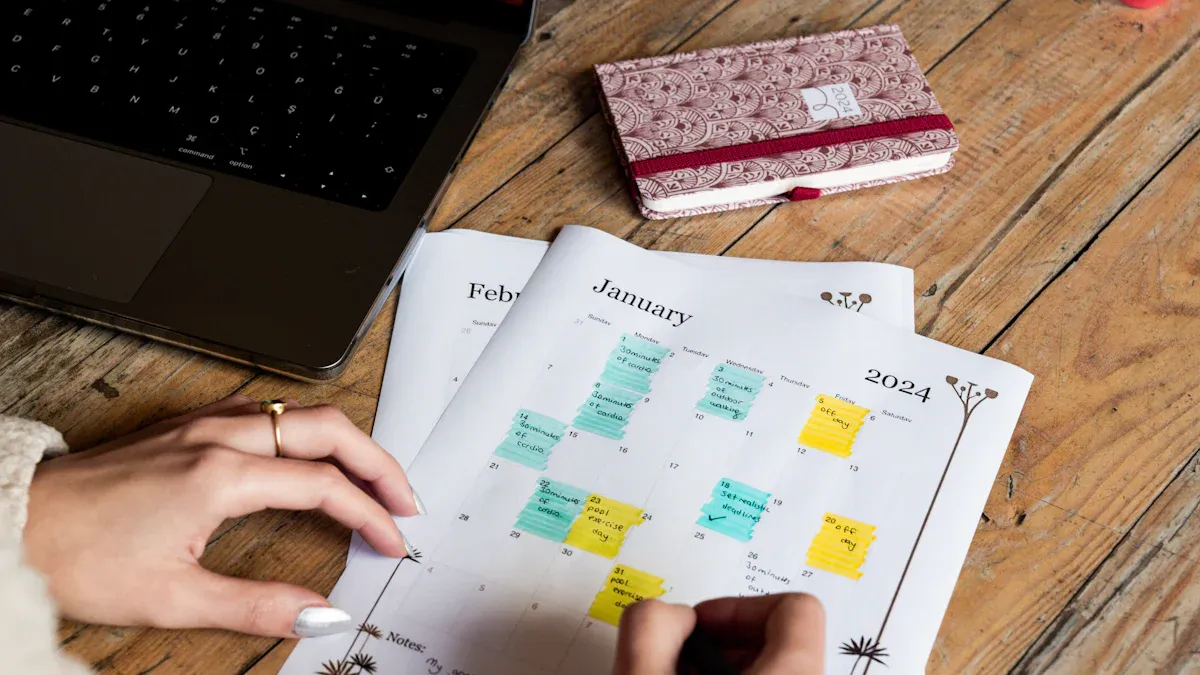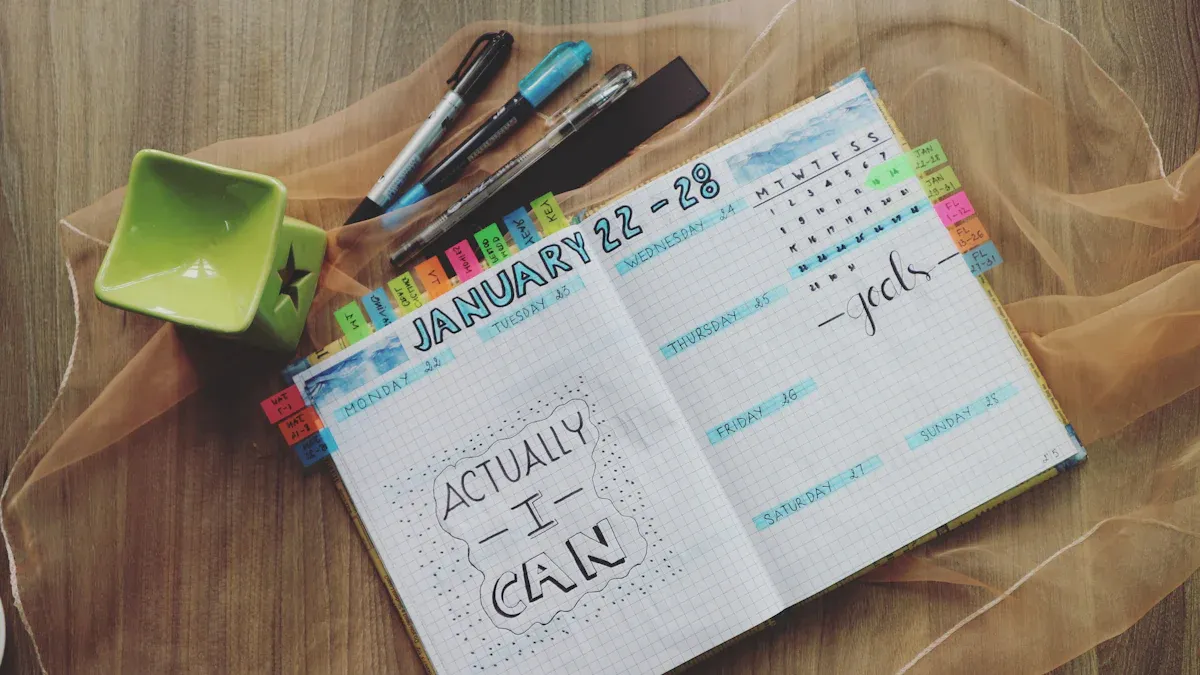How a daily planner with time blocking can transform your schedule

Image Source: pexels
You often feel overwhelmed by tasks and distractions. A daily planner with time blocking gives you a clear way to organize your day. Time blocking splits your schedule into focused blocks. You decide what to do and when to do it. This time management approach keeps you on track and helps you avoid wasted hours. Many people use this productivity technique to stay focused. With a daily planner with time blocking, you build better habits. Tools like Codot make time blocking even easier by helping you set up your plan and stick to it.
Daily Planner with Time Blocking

Image Source: pexels
What Is Time Blocking?
Time blocking means you split your day into time blocks. Each block is for one task or activity. This helps you focus on just one thing. You do not try to do many things at once. You get fewer distractions. Experts say time blocking helps you work better and finish faster.
Here are the main ideas of time blocking:
| Core Principle | Explanation | Example |
|---|---|---|
| Focus on a Single Task | You only do one task in each block. This helps you avoid mistakes and distractions. | Studies show doing many things at once makes you slower and causes more errors. |
| Plan Around Personal Productivity | You pick times when you feel most awake to do tasks. | Research shows you get more done when you match tasks to your best times. |
| Limit Task-Switching to Reduce Burnout | You change tasks less often. This lowers stress and helps you feel less tired. | Psychologists say switching tasks a lot can make you stressed and tired. Time blocking helps stop this. |
When you use time blocking, you control your schedule. You choose what to do and when. Your day feels easier and less stressful.
How It Works in a Planner
A daily planner with time blocking gives you a simple plan for your day. First, write down all your tasks. Next, give each task a time block. You can use paper or digital planners. Many people like digital planners because they are easy to change.
Here is how you use a daily planner with time blocking:
-
Write your tasks for the day.
-
Decide how long each task will take.
-
Put each task in a time block in your planner.
-
Add extra time between tasks for delays.
-
Leave some blocks open for breaks or surprises.
You can use AI tools like Codot to help with time blocking. Codot can organize your tasks, pick good times for each, and remind you when to switch. This helps you follow your plan and stay on track.
Tip: Try to do your most important tasks when you feel most awake. You will get more done and use less energy.
Key Features
A good daily planner with time blocking has many helpful features. These features make it easy to follow your plan and change it if needed. Here is a table of common features in top planners:
| Feature | Description |
|---|---|
| Task batching | Put similar tasks together to save time and stay focused. |
| Buffer times | Add extra time between tasks for delays or changes. |
| Flexibility | Change your plan when things come up. |
| Protect peak productivity hours | Do important tasks when you feel most awake and focused. |
| Planning for interruptions | Save time for surprises or urgent things. |
| Avoid overscheduling leisure | Leave some free time to relax and rest. |
| Intentionality and prioritization | Pick your most important tasks and do them first. |
| Time tracking integrations | Use apps to see how you spend your time and plan better. |
A daily planner with time blocking helps you build good habits and use your time well. If you use a tool like Codot, you get smart tips, reminders, and easy planning. This makes it simple to use time blocking and reach your goals.
Benefits of Time Blocking
Focus and Productivity
You can boost your focus and productivity with time blocking. When you set aside blocks of time for each task, you give your full attention to one thing at a time. This method helps you avoid distractions and keeps your mind on track. You do not waste time switching between tasks. Many people find that they finish work faster and make fewer mistakes. Time blocking also helps you see how much you can get done in a day. You feel more in control and less overwhelmed.
Tip: Try using time blocking for your most important tasks first. You will notice how much more you can achieve when you focus.
Prioritization and Structure
Time blocking gives your day clear structure. You know what to do and when to do it. Studies show that this method helps you manage your workload and set realistic goals. Here are some ways time blocking helps you prioritize and organize your day:
-
You schedule specific time slots for tasks, making your workload feel easier to handle.
-
You learn to estimate how long tasks take, which improves your planning skills.
-
You give priority tasks their own time, so you do not rush or waste time on less important work.
-
You spot unrealistic deadlines and can rearrange your plan.
-
You set self-deadlines, which helps you avoid putting things off.
-
You stop switching between tasks, which can waste up to 40% of your productive time.
These steps show why the benefits of time blocking include better planning and a more organized day.
Stress Reduction
Time blocking can lower your stress. Research shows that when you use time blocking, you feel more in control of your schedule. You know what to expect and can plan for surprises. This structure helps you feel calm and ready for each day. People who use time blocking often report less anxiety and better emotional health. Flexible time blocking also helps you handle changes without frustration. Over time, you build confidence and protect yourself from stress and burnout. The benefits of time blocking go beyond work—they help you feel better in daily life.
Time Blocking Method: Step-by-Step

Image Source: pexels
You can change your daily routine with time blocking. This guide will show you how to use time blocking in your planner. You will learn to set up your planner, put tasks in blocks, plan breaks, and stay flexible. Tools like Codot help by making scheduling and reminders simple.
Set Up Your Planner
Get your planner ready for time blocking. Follow these steps to start strong:
-
Think about why you want to use time blocking. Decide what you hope to achieve and make clear goals.
-
Add things you do every day first. Put in meals, sleep, and habits to make a real schedule.
-
Give yourself more time than you think for each task. This helps your plan work and lets you change things if needed.
-
Plan breaks and extra time between tasks. These help you stay focused and not get too tired.
-
Check and change your time blocks often. This helps you get better at planning and know yourself more.
Tip: Codot can help you set up your planner. It organizes your tasks, suggests time blocks, and sends reminders. You can add tasks by talking or typing.
Assign Tasks to Blocks
Putting tasks into time blocks is the main part of time blocking. You need to choose what to do and when. Here is how to use time blocking for your daily tasks:
-
Write down all your tasks for the day. Include work, personal, and daily things.
-
Put similar tasks together. This saves time and helps you focus.
-
Guess how long each task will take. If you are new, give yourself extra time.
-
Use a calendar app or planner to see your time blocks. This helps you follow your plan.
-
Make time blocks for things you do often, like checking email or making calls. This keeps you from getting distracted.
-
Tell others about your schedule. This stops last-minute meetings from messing up your plan.
Codot uses AI to help you pick which tasks to do first. It uses smart rules to sort your tasks by what is most important. Codot changes your plan as things come up, so you always work on what matters.
| Task Assignment Tips | Description |
|---|---|
| Task batching | Group similar tasks for efficiency |
| Visual tracking | Use a planner or app to see your schedule |
| Routine blocks | Reserve time for daily habits |
| Communication | Share your plan to avoid interruptions |
Schedule Breaks
Breaks are very important in time blocking. Science says your brain can focus for 90 to 120 minutes before needing a break. You should plan breaks after each work block to rest and keep working well.
-
Plan short breaks after every 90-120 minutes of work.
-
Add extra time between tasks for delays or surprises.
-
Do not skip breaks, even if you are busy. Breaks help you think better and come back with more energy.
Note: Codot’s reminders can tell you when it is time for a break. These reminders change to fit your habits, so you never miss a rest.
Stay Flexible
Being flexible makes time blocking work better. You can change your plan and still get things done. Here are ways to stay flexible:
-
Try a mix of strict and open time blocks. Block time for important things and leave some time open.
-
On busy days, block all your tasks to stay focused. On easy days, use the Anchor Technique to pick tasks based on how you feel.
-
Use strict time blocks for big events and open blocks for less important things.
-
Change your plan as your day changes. Codot can move tasks for you when things come up.
-
Look at your schedule often. Make changes to help you work better and not feel stuck.
Tip: Codot’s AI learns what you like and changes your plan. You get easy scheduling and updates, so you stay on track even when things change.
You can use time blocking in your daily routine with these steps. The time blocking method helps you stay organized, focused, and less stressed. Codot helps you with smart tips, reminders, and easy planning, so you can reach your goals.
Overcoming Challenges
Estimating Time Accurately
You may find it hard to guess how long a task will take. Many people either give too much or too little time for their work. This can make your schedule feel off. To get better at this, start by tracking your time for a week or two. Write down how long each task takes. Soon, you will see patterns. You can use this information to plan better in the future.
Try these steps to improve your time estimates:
-
Record the start and end time for each task.
-
Review your notes at the end of the week.
-
Adjust your future time blocks based on what you learned.
Tip: Add extra time to each block. This buffer helps you stay on track if something takes longer than you thought.
Avoiding Over-Scheduling
Over-scheduling is a common problem with time blocking. You might try to fit too much into your day. This can make you feel tired and stressed. To avoid this, focus on a few key tasks. Do not try to do everything at once.
Common pitfalls include:
-
Underestimating how long tasks take.
-
Skipping breaks or lunch.
-
Being too strict with your plan.
-
Ignoring your natural energy levels.
-
Not reviewing your plan each week.
-
Trying to do too much.
-
Letting others interrupt your focus time.
-
Saying yes to every request.
-
Wanting your schedule to be perfect.
You can avoid these problems by scheduling breaks, protecting your focus time, and learning to say no when needed.
Adapting to Change
Your day will not always go as planned. You may face interruptions or urgent tasks. Staying flexible helps you handle these changes. Build buffer times into your schedule. Use open blocks for tasks that may pop up. Review your plan each week and make changes as needed.
If you miss a block or need to move a task, do not worry. Progress matters more than perfection. Adjust your plan and keep going. Over time, you will get better at handling changes and keeping your schedule on track.
Note: Using a smart tool like Codot can help you adapt quickly. Codot can move tasks and update reminders when your day changes.
A daily planner with time blocking can help you work smarter and feel less stressed. Many professionals have seen big changes, like getting more done in less time and finding a better balance between work and life. You can start small—break your day into simple blocks and focus on one task at a time. Using a smart tool like Codot makes this process easier and more effective. When you build these habits, you gain control, boost your confidence, and see real results in your daily life.
FAQ
How do you start time blocking if you have never tried it before?
Begin by listing your tasks for the day. Choose one task for each time block. Use a planner or an app. Try short blocks first. Adjust your plan as you learn what works best for you.
Can you use time blocking for schoolwork and homework?
Yes, you can use time blocking for schoolwork. Assign each subject or homework task to a separate block. This helps you focus and finish your work faster. You will see better results and feel less stressed.
What if you miss a time block or fall behind?
Do not worry if you miss a block. Move the task to another time. Review your plan and make changes. Progress matters more than perfection. You will improve with practice.
How does Codot help with time blocking?
Codot organizes your tasks and suggests time blocks. You can add tasks by talking or typing. Codot sends reminders and updates your schedule when things change. You get smart tips to stay on track.